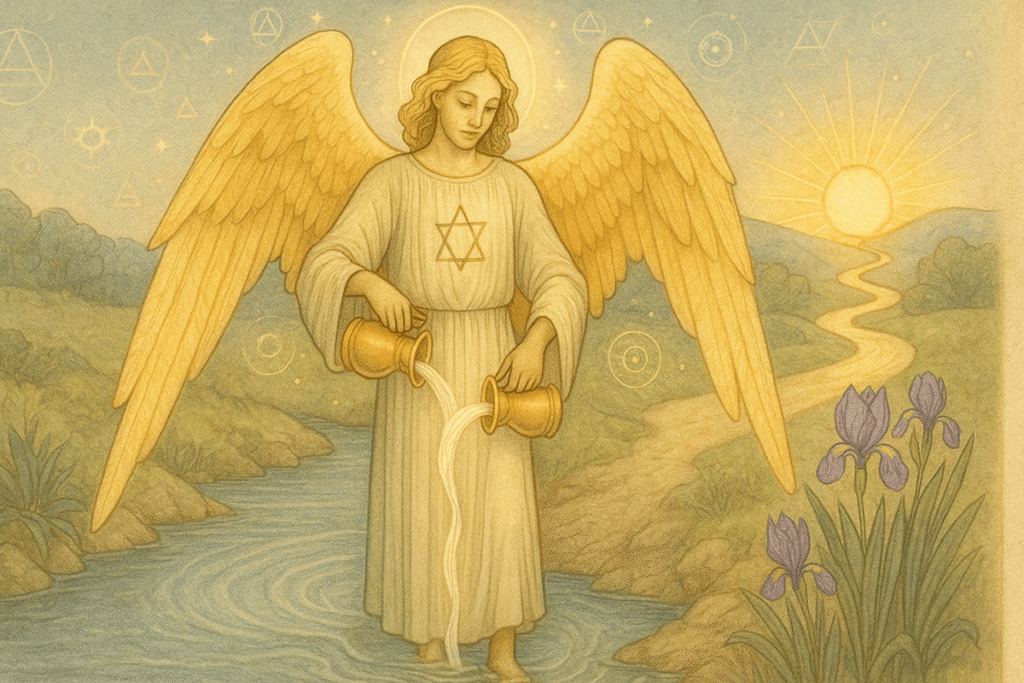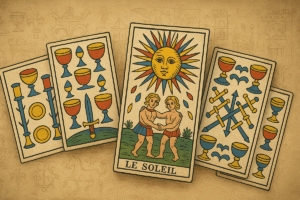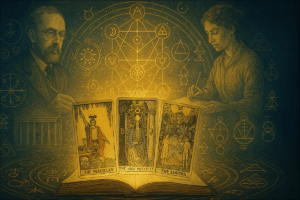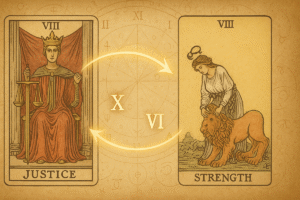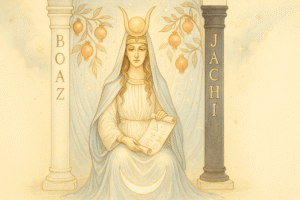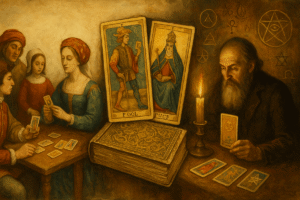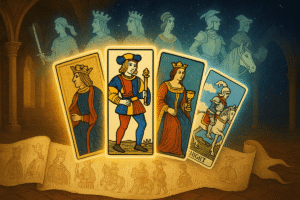Table of Contents
When I first encountered the Temperance card in my early days of exploring tarot, I’ll admit I found it puzzling. Among the more dramatic imagery of cards like The Tower or Death, here was this serene angel, calmly pouring water between two cups. It seemed almost too simple. But as I’ve spent more time with this card, I’ve realized that its quiet symbolism conceals layers of meaning that have been carefully woven together over centuries. Perhaps that’s the point. Temperance doesn’t shout its wisdom; it whispers it through a language of alchemical symbols and spiritual metaphors.
Today, I want to walk you through the rich iconography of this card. We’ll explore each element in detail, from the angelic figure at its center to the tiny irises blooming at the water’s edge. My hope is that by understanding these symbols, you might find new questions to ask yourself when this card appears in your readings.
The Angel as Mediator Between Worlds
The central figure in the Temperance card is typically depicted as an angel, though some decks show a more ambiguous celestial being. This choice of imagery is significant. Angels in Western mystical traditions have long served as intermediaries, existing in that liminal space between the material and the divine. They’re not quite human, not quite purely spirit. They bridge these realms.
What strikes me most about the Temperance angel is the sense of balance it embodies. One foot rests on land, solid and earthly. The other dips into water, representing the emotional and subconscious realms. This positioning isn’t accidental. It suggests a state of being that encompasses both worlds simultaneously, neither fully grounded nor fully adrift.
The angel’s wings are often portrayed in colors that carry their own symbolism. Red and blue are common choices, representing passion and serenity, or action and contemplation. Some decks add white for purity or gold for divine illumination. The wings themselves might prompt you to consider what aspects of yourself feel elevated right now, or what parts of your nature seek to transcend everyday concerns.
I think the angel’s calm expression is worth noting too. There’s no strain visible in the act of pouring, no tension in the posture. The message here seems to be about effortless flow rather than forced control. When you encounter this card, you might ask yourself where in your life you’re trying too hard to manage outcomes, versus where you could allow a more natural integration to occur.
The Alchemical Marriage of Water and Cups
The most dynamic element of the card is surely the pouring of water between two vessels. This image draws directly from alchemical symbolism, where the mixing of substances represented the fundamental work of transformation. Alchemists weren’t just trying to turn lead into gold, though that’s the popular understanding. They were exploring how opposing forces could be combined to create something entirely new.
The two cups in the Temperance card can be read in multiple ways. Some interpreters see them as representing different aspects of consciousness, perhaps the rational mind and the intuitive heart. Others view them as symbols of opposing life forces that need to be brought into conversation with each other. The water flowing between them never seems to spill or splash chaotically. It forms an impossible arc, defying the normal laws of physics.
This impossible flow is actually one of my favorite details. It reminds me that the work of integration and balance isn’t always logical. You can’t always think your way to harmony. Sometimes the process involves a kind of magic, a willingness to trust in flows and patterns that don’t make immediate rational sense.
The cups themselves are worth your attention. Are they identical or different? In most traditional decks, they appear similar but not quite the same, suggesting that what’s being blended isn’t two identical quantities but two distinct essences that complement each other. What parts of your life or your personality feel separate right now? Where might there be value in allowing them to mix and inform each other?
The Path Leading Toward Distant Mountains
Behind the angel, many versions of the Temperance card show a winding path that leads toward mountains in the distance. Sometimes there’s a radiant sun or light source rising between those peaks. This background element is easy to overlook when you’re focused on the central action, but I believe it adds crucial context to the entire composition.
The path represents journey and progression. It’s not a straight highway but a meandering route that suggests patience will be required. Spiritual growth and personal integration don’t happen overnight. The mountains in the distance might symbolize ultimate goals or higher states of consciousness, but they’re clearly far away. There’s no shortcut visible, no helicopter to whisk the angel directly to the summit.
What I find particularly interesting is that the angel isn’t walking this path. The figure stands in a transitional space, perhaps at a riverbank or the edge of a pool. The path is there as a reminder of direction and purpose, but the current work involves this patient act of blending and balancing. Maybe the lesson is that before we can walk the path toward our aspirations, we need to do this internal work of reconciling our contradictions.
The rising sun between the mountains carries associations with enlightenment, new beginnings, and the promise of clarity that comes after darkness. It offers hope. When you see this card, you might reflect on what dawn looks like for you right now. What would it mean for light to break through in your current situation?
The Crown and the Solar Emblem
On the angel’s head, there’s typically a radiant symbol, often depicted as a sun with a glowing center. Some decks show this as a simple golden circle or a more elaborate crown. This solar imagery connects Temperance to themes of consciousness, illumination, and divine intelligence.
In alchemical traditions, the sun represented the masculine principle, gold, and perfection. Its placement on the angel’s head suggests that the work of temperance happens under the guidance of higher awareness. The balanced blending of opposites isn’t random experimentation. It’s guided by something luminous and wise.
I sometimes wonder if this crown reminds us that the process of integration deserves respect. It’s sacred work, not casual tinkering. When you’re trying to balance conflicting needs or harmonize different parts of your life, perhaps you’re engaged in something that’s more profound than simple problem solving.
The Triangle Within the Square
Many traditional versions of the Temperance card show the angel wearing a white robe with a triangle inside a square on the chest. This geometric symbol is packed with esoteric meaning. The triangle often represents fire, spirit, or the divine trinity. The square grounds it, representing earth, matter, and the physical realm.
Together, they form what alchemists called the “squaring of the circle” or the integration of heaven and earth. It’s another visual echo of the card’s central theme of bringing opposites into productive relationship. The triangle pointing upward suggests aspiration and spiritual elevation, while the square contains and gives that aspiration practical form.
These aren’t symbols you need to intellectually decode every time you see the card, but I think knowing they’re there adds a layer of depth to your contemplation. They reinforce that Temperance isn’t about choosing between the spiritual and the material, the ideal and the practical. It’s about wedding them together.
Irises Blooming at the Water’s Edge
At the feet of the angel, near where the water meets the land, many decks show irises growing. These flowers aren’t mere decorative flourishes. The iris carries specific symbolic weight that enriches the card’s meaning.
In Greek mythology, Iris was the goddess of the rainbow and served as a messenger between the gods and humanity. She’s another bridge figure, another intermediary between realms. The flowers named after her thus carry associations with communication, connection, and the linking of separate worlds.
Irises also have connections to the French monarchy, where the fleur de lis became a symbol of purity and light. In the language of flowers, irises can represent faith, hope, and wisdom. Their presence at the threshold between water and earth, right where the angel stands, emphasizes that this liminal space is fertile ground. Growth happens at borders and boundaries.
I have to admit these small details are the ones that most enchant me about tarot imagery. You could study this card a dozen times and suddenly notice the irises for the first time, and that discovery opens up new avenues for reflection.
Bringing It All Together
After examining all these individual elements, what emerges is a portrait of conscious integration. Every symbol on the Temperance card points toward the same essential idea: that wholeness comes not from choosing one extreme over another, but from the patient, mindful blending of opposites.
The angel models this integration in posture, in action, and in decoration. The alchemical pouring demonstrates it in motion. The path, mountains, and rising sun promise that this work leads somewhere meaningful. Even the flowers remind us that this threshold space, uncomfortable as it might be, is where new life takes root.
When this card appears in your readings, you might sit with these symbols and see which ones speak to you most urgently. What are you being invited to blend or balance? Where do you stand with one foot in each of two worlds? What flows between the cups of your life right now?
These aren’t questions with simple answers, and perhaps that’s appropriate for a card as complex as Temperance. The symbols give us a language to explore our internal landscapes, but the meaning we discover there will be uniquely our own. That’s the beauty of this visual vocabulary. It’s been refined over centuries to offer maximum resonance while allowing maximum personal interpretation.
The next time you draw Temperance, I hope you’ll take a moment to really look at it. Notice the details we’ve explored here. Let them become doorways into your own reflections rather than fixed definitions to memorize. The card’s wisdom isn’t in knowing what each symbol means in an absolute sense. It’s in the contemplation itself, in the patient practice of seeking harmony and integration in your own way.
Frequently Asked Questions
Why is the Temperance angel depicted as androgynous or genderless?
The angel’s ambiguous gender represents the balance and integration of masculine and feminine energies, which is central to the card’s message of harmony between opposites. This androgynous quality emphasizes that true temperance requires blending all aspects of our nature rather than favoring one over the other, making the figure a perfect embodiment of the unity and wholeness the card teaches.
What does the impossible flow of water between the cups actually mean?
The water flowing upward or at an impossible angle between the cups symbolizes the magical nature of alchemical transformation and spiritual work. It shows that the process of integrating opposites isn’t bound by ordinary physical laws or logic, reminding you that personal growth and balance often involve a kind of mystery that defies rational explanation and requires trust in unseen processes.
Is the figure on Temperance Michael, Iris, or another specific entity?
The figure’s identity is intentionally ambiguous, with various interpretations suggesting the archangel Michael, the goddess Iris, or simply a representation of the virtue of Temperance itself. Rather than being a specific named being, the figure functions as a symbol of divine balance and spiritual alchemy, and what matters most is the principle of harmonious integration it embodies rather than a definite identity.
What is the significance of the irises at the water’s edge?
The irises reference Iris, the Greek goddess of the rainbow who served as a messenger between gods and humanity, reinforcing the card’s theme of bridging separate realms. These flowers grow at the threshold between water and land, symbolizing that liminal spaces where opposites meet are fertile ground for growth, faith, and the emergence of new wisdom.
Does the triangle within the square have alchemical meaning?
Yes, the triangle typically represents fire, spirit, or divine aspiration pointing upward, while the square represents earth, matter, and physical reality that contains and grounds that aspiration. Together they symbolize the alchemical principle of integrating heaven and earth, showing that Temperance isn’t about choosing between spiritual and material concerns but about wedding them together in productive harmony.

